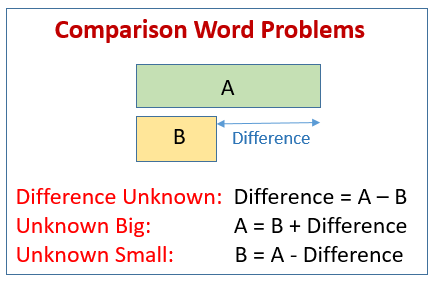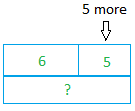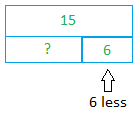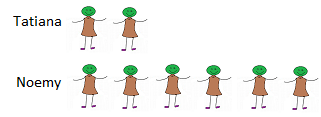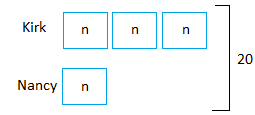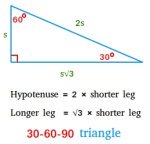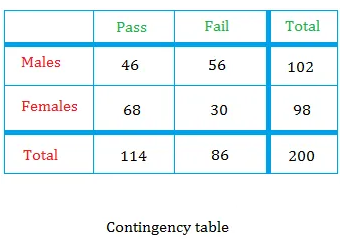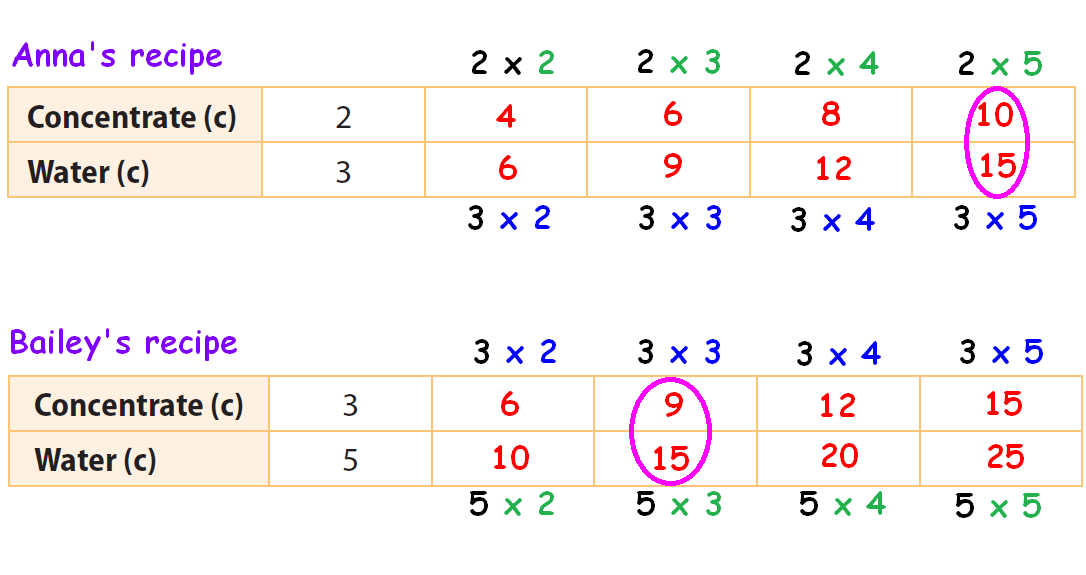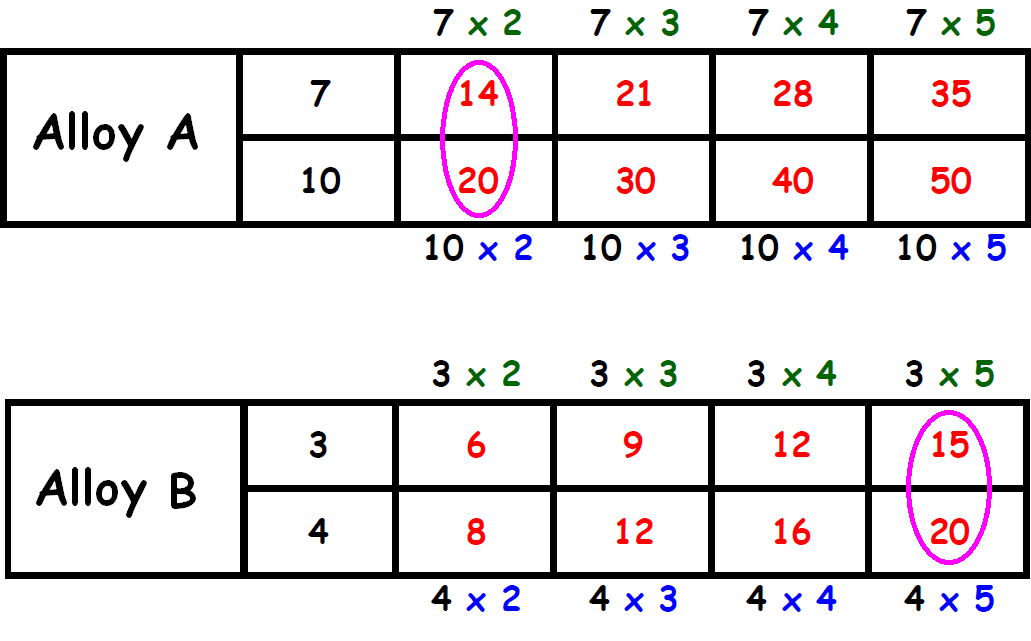The following diagrams show the three types of comparison word problems: Difference Unknown, Unknown Big Quantity, Unknown Small Quantity. Scroll down the page for examples and solutions.
Types of Comparison Word Problems
There are three main types of comparison word problems.
Difference Unknown
Connie has 15 red marbles and 28 blue marbles. How many more blue marbles than red marbles does Connie have?
This is a subtraction problem.
28 — 15 = 13
Unknown Big Quantity
Connie has 15 red marbles and some blue marbles. She has 13 more blue marbles than red ones. How many blue marbles does Connie have?
This is an addition problem.
15 + 13 = 28
Unknown Small Quantity
Connie has 28 blue marbles. She has 13 more blue marbles than red ones. How many red marbles does Connie have?
This is a subtraction problem.
28 -13 = 15
How to solve comparison word problems using Bar Models or Tape Diagrams?
This video explains how to use bar modeling in Singapore math to solve word problems that deal with comparing. This technique of using model drawings to solve word problems is recommended by the Common Core mathematics standards.
Example:
Adam has 11 fewer lollipops than Hope. If Adam has 16 lollipops, how may lollipops does Hope have?
- Show Video Lesson
Bar Model (Comparison)
This video employs a visual way to solve world problems using bar modeling. This type of word problem uses the comparison model. Because the part is missing, this is a subtraction problem.
Example:
Cayla did 88 sit-ups in the morning. Nekira did 32 sit-ups at night. How many more sit-ups did Cayla do than Nekira?
- Show Video Lesson
How to solve comparison word problems using Comparison Bars?
This is another strategy that we can use for story problems that involves comparison.
Examples:
- Bob has 14 crackers. Steve ate five fewer than Bob. How many did Steve eat?
- David has 5 marbles. Anna has 8 marbles. How many more does Anna have than David?
- Ellie has 9 goldfish. Laney has 5 more goldfish than Ellie. How many goldfish does Laney have?
- Mark earned $428 doing yard work. Troy earned $186. How much less did Troy earn?
- Billy has 679 gumballs. He has 278 more gumballs than Lee. How many gumballs does Lee have?
- Jake has 219 bottlecaps. Then, he found some more. Now he has 347 bottlecaps. How many bottlecaps did he find?
-
Show Video Lesson
Comparison Bars
Examples:
- Claire has 8 marbles. Sasha has 15 marbles. How many more marbles does Sasha have than Claire?
- Bill read 5 books. Beth read 2 more books than Bill. How many books did Beth read?
- Beth read 8 books. Bill read 3 fewer books than Beth. How many books did Bill read?
Example:
The Nature Center has a collection of snakes. The redbelly snake in the collection is 9 inches long. The eastern ribbon snake is 21 inches long. How much longer is the eastern ribbon snake than the redbelly snake?
Try the free Mathway calculator and
problem solver below to practice various math topics. Try the given examples, or type in your own
problem and check your answer with the step-by-step explanations.
We welcome your feedback, comments and questions about this site or page. Please submit your feedback or enquiries via our Feedback page.
Comparison word problems in elementary schools
Students may start solving comparison word problems as early as first
grade. Then, these problems get more and more challenging in 4th or 5th
grade. There are two types of comparison in math: additive and
multiplicative.
Next we show some examples commonly used in elementary schools.
Additive comparison
In additive comparison, the problem may have the following expressions where x can be a whole number.
- How much more?
- How much less?
- x more
- x less
Example #1
Darline has 6 candies. Sylvia has 5 more. How many candies does Sylvia have? Here is the model for this problem.
Sylvia has 6 + 5 candies or 11 candies.
Example #2
John has 15 books. Peter has 6 less. How many books does Peter have? Here is the model for this problem.
Peter has 15 — 6 or 9 books
Multiplicative comparison
In multiplicative comparison, the problem may have the following expressions where x can be a whole number.
- x times as many
- x times more … than
Example #3
Noemy has 3 times as many dolls as Tatiana. Tatiana has 2 dolls. How many dolls does Noemy have?
Step 1
Draw a model for this situation.
Step 2
Use the model to write an equation. Let n be the number of dolls Noemy has.
n = 3 x 2
Step 3
Solve the equation. n = 3. so Noemy has 6 dolls.
A challenging comparing word problem in elementary school.
Example #4
Kirk has 3 times as many baseball cards as Nancy. Together, they have 20 baseball cards. How many cards does Kirk have?
Step 1
Draw a box with the letter n in it to show that Nancy has an unknown number of cards. Kirk has 3 times as many cards as Nancy, so draw three identical boxes to represent Kirk’s cards.
Step 2
Use a model to write an equation. There are 4 equal boxes and each box has n cards.
To get the total numbers of cards, you need to do 4 x n. This amount must equal to 20 cards. So 4 x n = 20
Step 3
Solve the equation to find n.
4 times what number is equal to 20? Since 4 x 5 = 20, n = 5.
Nancy has 5 baseball cards.
Step 4
Find how many cards Kirk has. Kirk has 3 times as many as Nancy or 3 x 5.
Kirk has 15 cards.
Example #5
Kirk has 3 times as many baseball cards as Nancy. Together, they have 20 baseball cards. How many cards does Kirk have?
Recent Articles
-
30-60-90 Triangle
Apr 03, 23 05:08 PM
What is a 30-60-90 triangle? Definition, proof, area, and easy to follow real-world examples.
Read More
-
Calculate the Conditional Probability using a Contingency Table
Mar 29, 23 10:19 AM
Learn to calculate the conditional probability using a contingency table. This contingency table can help you understand quickly and painlessly.
Read More
10000+ results for ‘word problems comparing’
Word Problems
Open the box
by Tfisch
G2
fluency
Math
word problems
Comparing Fractions in Word Problems
Quiz
by Kjhoekwater
G3
Math
Comparing Fractions in Word Problems
Quiz
by Doralopez1
Comparing Fractions in Word Problems 2
Quiz
by Doralopez1
Comparing Fractions in Word Problems 2
Quiz
by Mdwwce
Word Problems 1st grade
Quiz
by Dcbrown8a
G1
Word Problems
Gameshow quiz
by Ashlynn2
G2
Math
Division Word Problems
Open the box
by Samiller
G3
Division
Word Problems
Group sort
by Edigera
word problems
Gameshow quiz
by Kcuellar
K
G1
Math
MATH Word Problems
Open the box
by Wfox
G2
G3
Math
Word Problems
Quiz
by Kimberlyburns
K
Word Problems
Gameshow quiz
by Spadoneamy
Word Problems — +/-
Quiz
by Jmaris
G2
Word Problems
Gameshow quiz
by Nina126
More or Less 1-5
Quiz
by Erinbecerra
K
Math
Comparing Numbers
Christmas Comparing Numbers 1-10
Gameshow quiz
by Erinbecerra
K
Math
Comparing Numbers
Word Problems keywords
Group sort
by Angelinacave
Word Problems 3 — Fluency
Match up
by Brandsk
G1
Math
Two-Step Word Problems
Random wheel
by Jessicatmm
Word Problems
Open the box
by Ralvarez7
Word problems
Open the box
by Kelly135
K
G1
Math
Word Problems 2 — Fluency
Open the box
by Brandsk
G1
Math
Two-Step Word Problems
Open the box
by Jaclynlowdermil
G5
Math
Special Education
Word Problems — Fluency
Gameshow quiz
by Brandsk
G1
Math
Mixed Math Word Problems
Quiz
by Nyin1
G2
Math
Multiplication Word Problems
Gameshow quiz
by Alyssanunez
G3
Math
Elapsed Time Word Problems
Gameshow quiz
by Ccrakita
Subtraction Word Problems
Match up
by Jfloman
Subtraction Word Problems
Match up
by Laurentyree
MATH GAMES Word Problems
Open the box
by Rheavner
Math
multiplication word problems
Quiz
by U40624915
Multiplication Word Problems
Open the box
by Samiller
Math
MULTI-STEP WORD PROBLEMS
Gameshow quiz
by Tjunkle
Math
Addition word problems
Quiz
by Floreft
G1
Math
Addition/Subtraction Word Problems
Quiz
by Kaylakarbowski
2 Step Word Problems
Open the box
by Denise27
Subtraction Word Problems
Gameshow quiz
by Missel7
K
Math
Comparing Numbers 1-5
Quiz
by Erinbecerra
K
Math
Comparing Numbers
word problems
Gameshow quiz
by Emoelobe
Word Problems (-)
Quiz
by Susywhiteandry
Word Problems
Match up
by Georgealvarez17
Word Problems
Random wheel
by Farrellm
Word Problems
Quiz
by Ccrakita
Word Problems
Open the box
by Lindseyalfonso6
Word Problems
Random wheel
by Chambersj
word problems
True or false
by Conovcad000
G3
Word Problems
Open the box
by Rparadisin
Word Problems
Match up
by Jhemdiaz112213
G10
Math
Word Problems
Open the box
by Kkarby
Word Problems
Quiz
by Danhoffmana
K
Math
Word Problems 1st grade
Flash cards
by Kempintutor
G1
Math
word problems
Gameshow quiz
by Emoelobe
Word Problems
Quiz
by Royiyew629
Word Problems
Open the box
by Kfuller1
Word Problems
Gameshow quiz
by Georgealvarez17
Word Problems
Gameshow quiz
by Georgealvarez17
Word Problems
Random cards
by Beckamy
Word Problems
Quiz
by Kimberlyburns
+/- Word Problems
Open the box
by U57581781
Compare word problems can be some of the most difficult addition and subtraction problems for students to solve. In this type of problem, students are asked to compare two groups of objects and determine which group has more/less/the same. This can be a difficult concept for students to grasp, but with some careful instruction and practice, they can master it!
Do your students struggle with word problems? What about those really hard ones: compare word problems? This is the most difficult addition and subtraction word problem by problem type.

Here are some tips for teaching students to solve compare word problems:
Use Real-World Problems
Teach students how to compare objects by using real-world examples. In our second-grade classroom, we measure our hands and feet and then spend quite a bit of time comparing those measurements.
We attach mathematical language to the activity and help students see how the words more than and less then relate to the measurements. We also show students how those terms can be changed around in the question and answer and the importance of really reading the question.
Model Compare Word Problems
One of the best ways to teach students to solve compare word problems is to model the process for them. Show them how you would approach the problem and think aloud as you work through it. This will help them see that there is a method to solving these types of problems.
Write out a few examples on the board and have students work through them as a class. Then, have students work in small groups or pairs to solve additional problems. Finally, allow students time to work independently on a few problems. By the end of the lesson, students should have had ample opportunity to see and solve compare word problems.
Use Manipulatives
Encourage students to use manipulatives. Many students find it helpful to use manipulatives (e.g., counters, linking cubes, etc.) when solving compare word problems. Manipulatives can help solidify the concept for some students and make the problem-solving process less abstract.
Compare Word Problems – Facebook Live
I have a great Facebook Live where I show you the differences between the Compare problems types. You can watch the Facebook Live below or visit this link to see it on Facebook.
Some other Word Problem Resources
- Join Word Problems – Facebook Live
- Separate Word Problems – Facebook Live
- Addition & Subtraction Word Problems by Problem Type – Product Overview
- 5-Tips: How to Teach Students to Solve Word Problems
- The Problem with Using Keywords to Solve Word Problems
Free Word Problems Sample
Do you want a free sample of the word problems I use in my classroom? Click the link or the image below. FREE Sample of Word Problems by Problem Type
Word Problems Teaching Resources for Your Classroom
Are you teaching word problems and do you need more resources to meet the needs of all of your learners? Check out these word problem resources for your classroom.
-
Multiplication Division Word Problems Number Puzzles – OA3
$3.75
-
Two-Step Word Problems Number Puzzles – OA8
$3.75
-
Addition and Subtraction Word Problems by Problem Type
$24.75
-
Multiplication and Division Word Problems
$19.75
-
Word Problem by Problem Type BUNDLE
Product on sale
$38.80
-
Second Grade Math BUNDLE
$200.00
More Ideas for Teaching Word Problems
Are you looking for more ideas for teaching word problems to your elementary students? Check out these blog posts.
7 Responses
-
Great website that promotes higher level thinking.
-
What an amazing presentation! Thank you for sharing your knowledge and using technology so efficiently to model how to solve different comparison word problems.
Thank you for taking the time to create resources that help us teachers be more effective when teaching math concepts/skills! You are awesome!
-
Thanks Jessicca for sharing such a great tips for the World and students to solve the compare-world problem
-
Do you have videos on part part whole word problems?
-
No, sorry. It’s just the one I never got around to doing on video for. It’s also the easiest problem type and generally introduced in Kindergarten with real-world objects that move to students draw the problems. As students progress, they move from objects > drawings > models (like bar-models). The number line will be similar to join / separate / compare, depending on what is known / unknown. However, since there is no movement or comparison, students may choose to use a different strategy to solve the problem.
-
-
Do you sell your Word Problem teaching Videos? I would like to be able to view them without having to go to the website. I have learned so much from your videos, please make them available to us.
-
Leave a Reply
Problem 1 :
Anna’s recipe for lemonade calls for 2 cups of lemonade concentrate and 3 cups of water. Bailey’s recipe calls for 3 cups of lemonade concentrate and 5 cups of water. Whose recipe makes stronger lemonade ? How do you know ?
Solution :
Anna’s recipe :
2 cups of lemonade and 3 cups of water.
So, the ratio is 2 : 3.
Let us write equivalent ratios to the ratio 2 : 3.
Bailey’s recipe :
3 cups of lemonade and 5 cups of water.
So, the ratio is 3 : 5.
Let us write equivalent ratios to the ratio 3 : 5.
Find two columns, one in each table, in which the amount of water is the same. Circle those two columns.
From the circled columns, we get two ratios.
They are,
10 : 15 and 9 : 15
In these two ratios, the second quantity (water) is same.
So, we have to compare the first quantity (Lemonade).
The first quantity (10) in the first ratio is more than the first quantity (9) in the second ratio.
When the amount of water is same (15) in both recipes, Anna’s recipe has more quantity of lemonade concentrate.
Therefore, Anna’s recipe has stronger lemonade.
Problem 2 :
There are two alloys A and B, both are made up of gold and copper. The ratio between gold and copper in each alloy is given below.
Alloy A (G : C)—-> 2 1/3 : 3 1/3
Alloy B (G : C) —-> 3.6 : 4.8
In which alloy do we have more gold ?
Solution :
To know the alloy in which we have more gold, we have to compare the given two ratios.
To compare two ratios, both the terms of the ratio must be integers.
Let us convert the terms of the first ratio into integers.
2 1/3 : 3 1/3 = (7/3) : (10/3)
2 1/3 : 3 1/3 = 7 : 10 ——> multiplied by 3
Let us write equivalent ratios to the ratio 7 : 10
Let us convert the terms of the second ratio into integers.
3.6 : 4.8 = 36 : 48 ——> multiplied by 10
3.6 : 4.8 = 3 : 4 ——> divided by 12
Let us write equivalent ratios to the ratio 3 : 4
Find two columns, one in each table, in which the the second term is same. Circle those two columns.
From the circled columns, we get two ratios.
They are,
14 : 20 and 15 : 20
In these two ratios, the second quantity (copper) is same.
So, we have to compare the first quantity (gold).
The first quantity (15) in the second ratio is more than the first quantity (14) in the first ratio.
When the quantity of copper is same (20) in both the alloys, Alloy A has more quantity of gold.
Therefore, we have more gold in alloy A.
Kindly mail your feedback to v4formath@gmail.com
We always appreciate your feedback.
©All rights reserved. onlinemath4all.com

